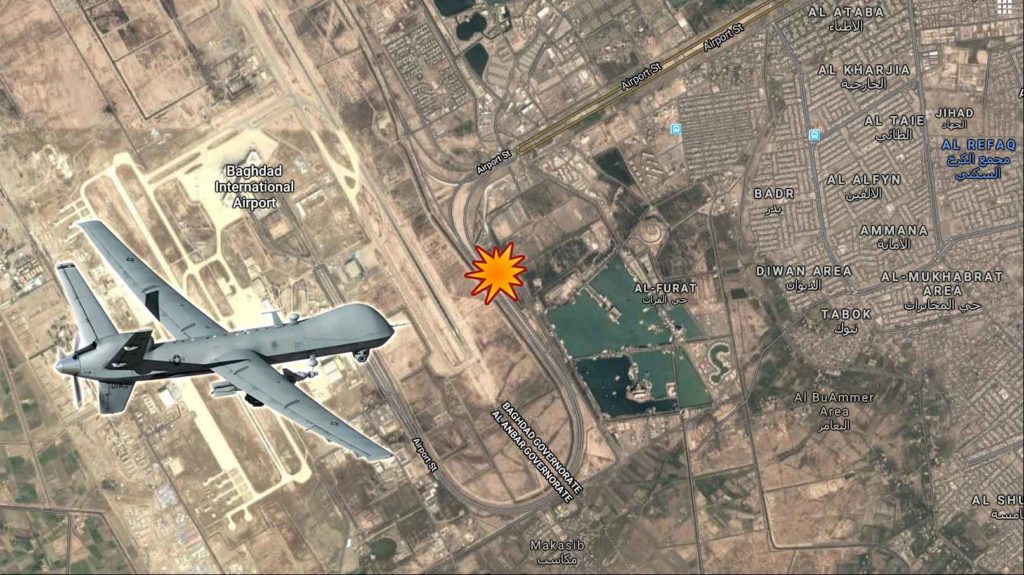
The key figures in the January 3 U.S. airstrike that killed Qassem Soleimani have been identified, most notably Abu Mahdi al-Muhandis, deputy commander of Iraq’s Popular Mobilization Forces (PMF) and commander of Kataeb Hezbollah. Abu Mahdi al-Muhandis was listed as a terrorist in the United Arab Emirates and the United States. Some security experts are divided on whether Muhandis was specifically targeted or if he was a bonus kill.
Iranian and Iraqi officials have so far confirmed the U.S. attack killed ten people in addition to Soleimani. Rikar Hussein and Mehdi Jedinia of Voice of America give us the full list and their roles here. They are:
Abu Mahdi al-Muhandis – head of Iraq’s powerful anti-American Shiite group, Kataeb Hezbollah, and the deputy commander of Iraq’s Popular Mobilization Forces.
Major General Hossein Pourjafari (IRGC) – Soleimani’s right-hand man, who played a critical role in the formation of the Islamic Revolutionary Guard Corps (IRGC) intelligence wing.
Colonel Shahroud Mozaffari Nia (IRGC) – a member of IRGC’s intelligence unit who reportedly worked with pro-Iranian militias in Lebanon and Syria.
Lieutenant Hadi Taremi (IRGC) – a member of the IRGC security bureau for almost 10 years before his promotion to IRGC’s Quds Force unit.
Lieutenant Vahid Zamanian (IRGC) – reportedly one of the rotating bodyguards of Soleimani and accompanied him in some unofficial international visits. Additionally, he reportedly was involved in the IRGC-Quds Force’s Fatemiyoun Brigade, an all-Afghan militia formed in 2014 and sent to Syria to help the government of Bashar al-Assad in the fight against Sunni rebels.
Muhammad Radha al-Jabri (PMF) – in charge of airport protocol for the Iraqi Shiite militia known as the Popular Mobilization Forces.
Hassan Abdu al-Hadi, Muhammad al-Shaybani and Haider Ali (PMF) – bodyguards who were members of the Popular Mobilization Forces; theyIraq’sShiite media claim they were also among those killed in the attack.
Deputy Chief Naim Qassem (Hezbollah) – the deputy chief of the Lebanese militant group Hezbollah; he was reported among those killed in the U.S. strike in Baghdad, but the media office of the Shiite group has denied his death.
Peter Singer, an expert on future warfare at the New America Foundation, said the strike, “requires a truly immense intelligence, surveillance and reconnaissance effort — one which basically no other country in the world can match, and which is vastly expensive, time-consuming and requires lot of expertise.” Ken Dilanian and Courtney Kube of NBC News tells us the intelligence aspect came from Syria via informants, they write:
Armed with a tip from informants at the airport in the Syrian capital of Damascus, the CIA knew exactly when a jet carrying Iranian Gen. Qassem Soleimani took off en route to Baghdad. Intelligence from Israel helped confirm the details.
Once the Cham Wings Airlines Airbus A320 landed, American spies at Iraq’s main airport, which houses U.S. military personnel, confirmed its exact whereabouts.
Three American drones moved into position overhead, with no fear of challenge in an Iraqi airspace completely dominated by the U.S. military. Each was armed with four Hellfire missiles….
U.S. military officials watched a live feed of the strikes at various locations around the world. Despite the successful operation, the reaction was somber as the gravity of the attack set in and the officials contemplated what response it could unleash.
It was an operation utterly unremarkable for any technical or intelligence wizardry. It’s remarkable, rather, for how routine such lethal actions have become.
The targeted killing is the latest demonstration of how, two decades after the CIA spotted but was unable to kill a man they believed was al Qaeda leader Osama bin Laden in Afghanistan, the U.S. has become adept at hunting and killing its enemies, particularly in the troubled regions of the Middle East, South Asia and Africa.
“In less than a generation, we went from something that was abnormal and maybe even science fiction, to the point where it’s the new normal,” says Peter Singer, an expert on future warfare at the New America Foundation, said.. “Both leaders and the public don’t even blink an eye.”
Targeted strikes like the one that killed Soleimani represent a fundamental change in warfare, said Anthony Cordesman, who studies military trends at the Center for Strategic and International Studies in Washington.
Originally posted January 16, 2020.
If you’re willing to fight for Main Street America, click here to sign up for my free weekly email.




